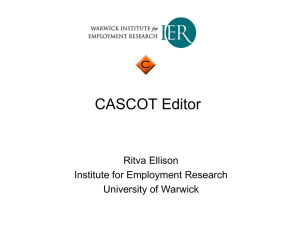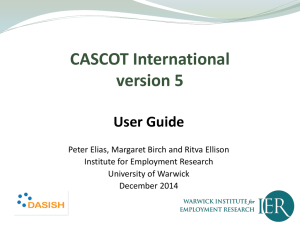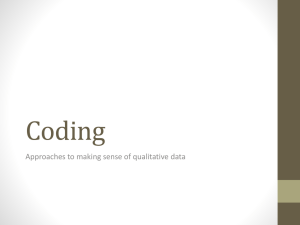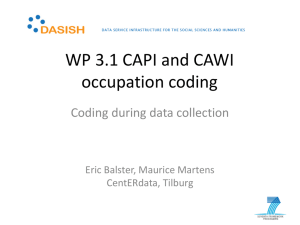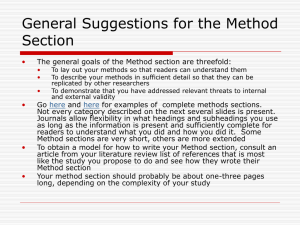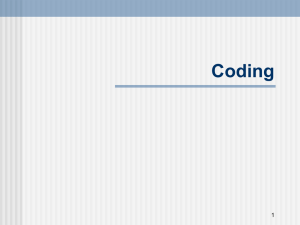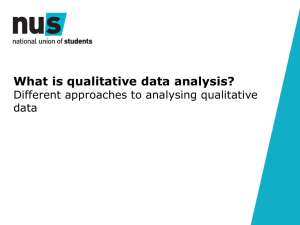(a multi-language text coding tool), Peter Elias
advertisement
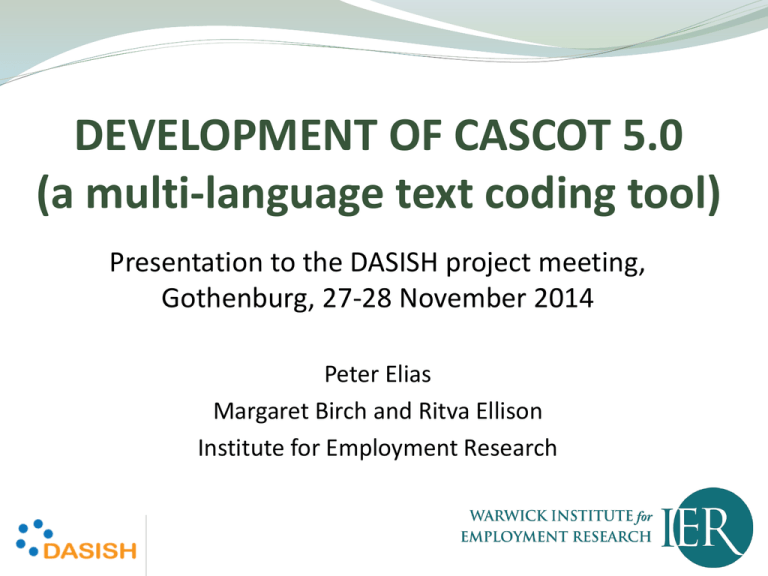
DEVELOPMENT OF CASCOT 5.0 (a multi-language text coding tool) Presentation to the DASISH project meeting, Gothenburg, 27-28 November 2014 Peter Elias Margaret Birch and Ritva Ellison Institute for Employment Research What are the problems with occupation coding? Occupation is a standard measure on most national social surveys (ISCO’08) Not straightforward to collect and in non-standard (unstructured) form Requires harmonisation to (max) four-digit classification Requires specialist knowledge and expertise to code accurately Computer Assisted Structured Coding Tool CASCOT Software tool for coding text automatically or manually, or mixing the two modes. Developed at the Institute for Employment Research at University of Warwick 1993 - 2014 • Used by over 100 organisations (public research, private sector, statistical agencies) • Fast with a sophisticated coding engine • Desktop version, API available: see www.warwick.ac.uk/cascot Selected classification Enter text (could be from a file) Output can be directed to a file IER contracted within DASISH to develop a multilingual version of CASCOT to code job titles to ISCO 08 (WP3) CASCOT upgraded to provide: • a user interface which is presented in up to 3 selected European languages; • classification files which permit coding of text in selected languages to the appropriate national occupational classification and to ISCO’08 at four digits; • a software tool which will facilitate evaluation of coded text files. Upgraded to facilitate future extension by incorporating additional languages as and when relevant index material becomes available. DASISH: CASCOT development User interface in 8 languages: Dutch, English, French, German, Italian, Portuguese, Slovak and Spanish ISCO 08 classification (structure, index) prepared for each country Simultaneous coding into ISCO 08 and national occupational code possible Development of CASCOT Performance Tool Raw data files from the European Social Survey (ESS) Round 6 used for validation Partnership arrangements for the testing and fine-tuning by experts within each country Collaboration and Training DASISH WP3 Group meeting, London, April 2012 DASISH Quantitative Workshop, Mannheim, December 2012 GESIS Workshop on Developments in Occupational Coding, Mannheim, February 2013 Meeting with University Ca’ Foscari to discuss development of Italian version, Venice, August 2013 InGRID workshop on ‘Tools for harmonising the measurement of occupations’, Amsterdam, February 2014 CASCOT Training Workshop, Venice, April 2014 Users currently trialling/purchasing CASCOT v5.0 Cascot Performance Tool Allows the user to analyse the performance of Cascot by comparing data coded to ‘Gold Standard’ with code produced by Cascot for the same data. The Tool displays a Performance Graph, Summary and Interactive statistics. Enables the user to decide how much text should be coded automatically and what is left for (labour-intensive) human intervention. Research project: Health, Occupation, and the role of Measurement Error (HOME) A project designed to extend previous work (see poster in this room): Belloni, M., Brugiavini, A., Meschi, E. and Tijdens, K. (2014). Measurement error in occupational coding: an analysis on SHARE data. Universiteit van Amsterdam, AIAS Working Paper 151. http://www.uva-aias.net/publications/show/1978 • HOME was set up during visit to AIAS-UvA (Kea Tijdens) - thanks to an InGRID visiting grant • Access to restricted ELSA files has been funded by DASISH Aim and steps of HOME 1. Recode open-ended answers from ELSA using CASCOT 2. Evaluate agreement rates between ELSA and CASCOT 3. Convert ISCO codes on job features that may affect health: whether the job is physically demanding, psychosocial factors of the job, exposure to risk factors, etc. This conversion requires further data (and funding…) 4. Estimate models exploring links between individuals’ with individuals’ job characteristics 5. Evaluate whether and to what extent any estimated associations are sensitive to occupational miscoding. What have we learnt during DASISH? Modifications to CASCOT text matching Handling of compound words Treatment for equivalent word endings Processing/non-processing of spaces Modifications to CASCOT Add text descriptions to the classification structure to provide more information for the coder The need for ‘Gold Standard’ coded text files Next steps? Extend the development and testing of language-based coding rules in all relevant languages Continue fine-tuning the software to re-code job title text already coded to ISCO 08 (demonstrated at the Venice training workshop April 2014) NB Resource-demanding, time-consuming for each language. Expertise needed in language and occupation. (English coding rules developed in parallel with CASCOT over a decade or more.) Dependent on further funding. Further information Email: M.E.Birch@warwick.ac.uk Ritva.Ellison@warwick.ac.uk Peter.Elias@warwick.ac.uk CASCOT www.warwick.ac.uk/cascot Institute for Employment Research University of Warwick www.warwick.ac.uk/ier
